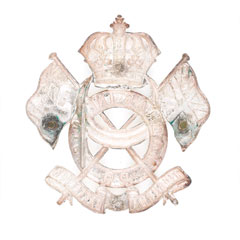
Online Collection
Pugri badge, 29th (7th Burma Battalion) Madras Infantry, 1893-1903
Silver badge, hallmarked 1898, with quoit bearing the unit title, '29 Madras Infantry', intertwined with a crescent, surmounted by a Guelphic Crown, on crossed Union and Royal Ensign flags, with a scroll below bearing the unit title, '7th Burma Battalion'.
The pugri or pagri is a form of headdress. Quoits, or chakram, are a traditional edged weapon from the Indian subcontinent, particularly associated with Sikh fighters. They take the form of a flattened metal ring of varying circumference, with a sharpened outer edge, which can be thrown or used in hand-to-hand combat.
Originally raised as the 3rd Extra Battalion of Madras Infantry in 1798, the 29th Regiment of Madras Native Infantry was formed in 1824. It served in Ceylon (Sri Lanka), Malaya and Burma. Continued service in Burma led to its designation as 29th Regiment (7th Burma Battalion) of Madras Infantry in 1893 and 29th Burma Infantry in 1901. As part of the Indian Army reform of 1903 the regiment became the 89th Punjabis. During World War One (1914-1918) the regiment was expanded and elements served in India, Aden, Egypt, at Gallipoli, on the Western Front, in Mesopotamia, and in Greece and the Caucasus. Amalgamation with other 'Burma Battalions' followed, with the unit forming the 1st Battalion, 8th Punjab Regiment in 1922.
From the Field Marshal Sir John Chapple Indian Army Collection.
NAM Accession Number
NAM. 2013-10-20-34-15
Copyright/Ownership
National Army Museum Copyright
Location
National Army Museum, Study collection
Object URL
https://collection.nam.ac.uk/detail.php?acc=2013-10-20-34-15


